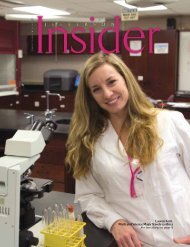state-ofthe-art
JCC_Insider_Fall_15
JCC_Insider_Fall_15
Create successful ePaper yourself
Turn your PDF publications into a flip-book with our unique Google optimized e-Paper software.
local groups would like more studies than the Center has the time and resources to conduct. The Center keeps its<br />
invoicing low thanks to a Car-Freshner Corporation endowment and support from the College, and maintains a<br />
steady flow of studies thanks to surveys it repeats on an annual basis.<br />
“We’re in really good shape,” he reported; otherwise, he said, he wouldn’t think about stepping down to concentrate<br />
on professional and personal goals, which include both academic and creative writing projects (he is a member of<br />
the SUNY Distinguished Professor Academy, and is the author of two published novels). Meanwhile, he will conduct<br />
one more Center survey this fall, for the North Country Prenatal/Perinatal Council.<br />
The community studies themselves yield information (via survey instruments) on topics such as local gambling behaviors,<br />
downtown Watertown retail space, recycling, airport usage, and resident viewpoints on local quality of life.<br />
Dr. Petersen cites the gambling-behaviors study as one example of a surprising outcome. Survey results showed<br />
that Jefferson County residents spent $50 million a year on gambling-related activities. “You can’t help think,” he<br />
notes, “what could we do with $50 million a year? How many jobs could you create?”<br />
Additionally, a CCS study for Hospice of Jefferson County established the need for the new Gotham St. Hospice facility;<br />
a study for Alexandria Bay’s E.J. Noble Hospital helped to transform it into today’s River Hospital, when it might<br />
have shut down or had its services radically curtailed. Annually, the Development Authority of the North Country is<br />
a major sponsor of three surveys the Center now conducts for Jefferson, Lewis, and St. Lawrence Counties.<br />
“If you compare our survey response rate to any other professionals in the field,” said Dr. Petersen, “we’d be the envy<br />
of them. Our response rate is great and that’s a tribute to the students who help with the surveys, and to how they<br />
conduct them.“<br />
Students make between 350-400 telephone calls over the course of three to four days when conducting<br />
research for the Center. When the community p<strong>art</strong>icipates, their opinions help to shape North Country policy and<br />
decision-making.<br />
Applied Learning for Jefferson Students<br />
For 17 years—since 1999—JCC math professor Joel LaLone has been the Center for Community Study’s secret<br />
weapon, the mastermind behind the data that emerges from its projects. His Mathematics Dep<strong>art</strong>ment colleague,<br />
Assistant Professor Larry Danforth, is stepping into the new position of Research Coordinator, though he has been<br />
involved in the work of the Center since 2011. Mr. LaLone and Mr. Danforth design, guide, and finalize the studies,<br />
but at the he<strong>art</strong> of their analysis is an applied-learning process whereby JCC statistics students are involved in every<br />
step of the survey projects.<br />
Technological advances have made mathematics “explode,” said Mr. LaLone, “with big data and all of that. Thirty<br />
years ago, I wouldn’t have been able to do some of this.”<br />
From development of the research questions to population identification, to definition of variables; to sample<br />
methodology, to data collection and data cleansing; to data analysis, data interpretation, and public presentation,<br />
JCC statistics students help with the work of the Center.<br />
If they man the phones, they are paid for their work; if they don’t, they will still process some of the collected information<br />
in their coursework. “It’s the same mathematics formulas as the canned problems in my book,” Mr. LaLone<br />
pointed out, “but I can imagine it’s more meaningful to work on things that really impact their community.”<br />
Per semester, between 150 and 200 students are involved with the Center’s data analysis. Frequently, the Math<br />
Dep<strong>art</strong>ment hears back from them once they go out into the work world, where they find themselves at an advantage<br />
due to their CCS activities. Mr. LaLone cites examples of students who received MBAs, but credit JCC ahead of<br />
their graduate institutions for where they are today—for example, Matt Biedekapp, described by K S & R Corp. of<br />
Syracuse as one of its “rising-star” employees.<br />
Mr. Danforth added, “We give information to the community that other communities don’t get. I come from Corning<br />
Community College, and Corning has to contract out for something like that.”<br />
A favorite statistical challenge is coming up with the methodologies for data collection. “You can’t just figure out<br />
how to do an economic analysis on Tug Hill by googling it,” said Mr. LaLone. “That’s been professionally gratifying,<br />
to have to keep learning and expanding.” Students, too, suggest improvements in designs or survey instruments,<br />
and they do on-the-job problem-solving, like the student who called Wal-M<strong>art</strong> in Lowville to learn Lewis County<br />
cell-phone prefixes. When students find unique angles in the research, that data sometimes ends up in Center<br />
reports.<br />
“These are great young minds,” Mr. LaLone said of his student assistants.<br />
He is pleased that his teaching methods give them opportunities to get involved. He added about the work of the<br />
Center, “I feel very fortunate that we (JCC) created this.”<br />
Jefferson Insider - Volume 13 • 11



